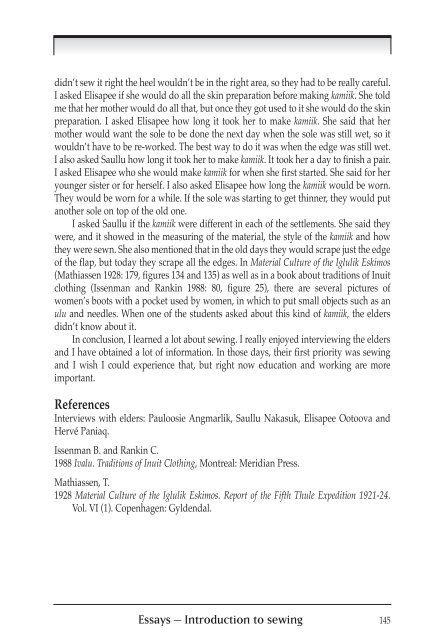Introduction-E
Introduction-E
Introduction-E
Create successful ePaper yourself
Turn your PDF publications into a flip-book with our unique Google optimized e-Paper software.
didn’t sew it right the heel wouldn’t be in the right area, so they had to be really careful.<br />
I asked Elisapee if she would do all the skin preparation before making kamiik. She told<br />
me that her mother would do all that, but once they got used to it she would do the skin<br />
preparation. I asked Elisapee how long it took her to make kamiik. She said that her<br />
mother would want the sole to be done the next day when the sole was still wet, so it<br />
wouldn’t have to be re-worked. The best way to do it was when the edge was still wet.<br />
I also asked Saullu how long it took her to make kamiik. It took her a day to finish a pair.<br />
I asked Elisapee who she would make kamiik for when she first started. She said for her<br />
younger sister or for herself. I also asked Elisapee how long the kamiik would be worn.<br />
They would be worn for a while. If the sole was starting to get thinner, they would put<br />
another sole on top of the old one.<br />
I asked Saullu if the kamiik were different in each of the settlements. She said they<br />
were, and it showed in the measuring of the material, the style of the kamiik and how<br />
they were sewn. She also mentioned that in the old days they would scrape just the edge<br />
of the flap, but today they scrape all the edges. In Material Culture of the Iglulik Eskimos<br />
(Mathiassen 1928: 179, figures 134 and 135) as well as in a book about traditions of Inuit<br />
clothing (Issenman and Rankin 1988: 80, figure 25), there are several pictures of<br />
women’s boots with a pocket used by women, in which to put small objects such as an<br />
ulu and needles. When one of the students asked about this kind of kamiik, the elders<br />
didn’t know about it.<br />
In conclusion, I learned a lot about sewing. I really enjoyed interviewing the elders<br />
and I have obtained a lot of information. In those days, their first priority was sewing<br />
and I wish I could experience that, but right now education and working are more<br />
important.<br />
References<br />
Interviews with elders: Pauloosie Angmarlik, Saullu Nakasuk, Elisapee Ootoova and<br />
Hervé Paniaq.<br />
Issenman B. and Rankin C.<br />
1988 Ivalu. Traditions of Inuit Clothing, Montreal: Meridian Press.<br />
Mathiassen, T.<br />
1928 Material Culture of the Iglulik Eskimos. Report of the Fifth Thule Expedition 1921-24.<br />
Vol. VI (1). Copenhagen: Gyldendal.<br />
Essays – <strong>Introduction</strong> to sewing 145


